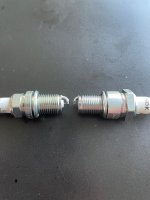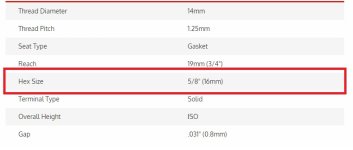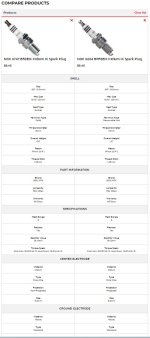revenson
Well Known Member
My experience after reading Paul Dye's article in Kitplanes, "Automotive Plugs in Lycomings", June 3, 2023. I also posted this as a comment online under the Kitplane article.
I’ve used PMAGS now for 13 years, always using the recommendation from the manual. However, after reading Paul’s article, the idea to use a higher torque for the adapter made sense.
So I tried it the other day with less than perfect results: I intentionally broke an old BR8ES plug at the base of the ceramic to allow plenty of room for my adapter size socket to clear this modified plug. Inserted the modified plug into the brass adapter and then torqued the adapter to 35 ft lbs. Backed out the modified plug, then inserted the real spark plug and torqued that to 16 ft lbs. This worked fine on 2 plugs.
But, on the third cylinder the adapter broke off prior to reaching 35 ft lbs. This left most of the adapter firmly in the spark plug hole. Since I was hoping to fly the next morning, this was a real disappointment. Fortunately, a local mechanic had the appropriate easy-out and was able to remove the broken adapter.
My torque wrench had not been recently calibrated, so maybe I was using too much torque. Also, my brass adapters were all 13 years old. As luck would have it, I intended to replace all adapters at next condition inspection. Regardless, my take is that while aviation plug torque may be fine for steel adapters, I think it’s too high for brass, particularly old brass.
I hope my experience may prevent someone else from having a similar problem. For me, I’m going back to the Emagair recommended method that has worked so well for 13 years.
I’ve used PMAGS now for 13 years, always using the recommendation from the manual. However, after reading Paul’s article, the idea to use a higher torque for the adapter made sense.
So I tried it the other day with less than perfect results: I intentionally broke an old BR8ES plug at the base of the ceramic to allow plenty of room for my adapter size socket to clear this modified plug. Inserted the modified plug into the brass adapter and then torqued the adapter to 35 ft lbs. Backed out the modified plug, then inserted the real spark plug and torqued that to 16 ft lbs. This worked fine on 2 plugs.
But, on the third cylinder the adapter broke off prior to reaching 35 ft lbs. This left most of the adapter firmly in the spark plug hole. Since I was hoping to fly the next morning, this was a real disappointment. Fortunately, a local mechanic had the appropriate easy-out and was able to remove the broken adapter.
My torque wrench had not been recently calibrated, so maybe I was using too much torque. Also, my brass adapters were all 13 years old. As luck would have it, I intended to replace all adapters at next condition inspection. Regardless, my take is that while aviation plug torque may be fine for steel adapters, I think it’s too high for brass, particularly old brass.
I hope my experience may prevent someone else from having a similar problem. For me, I’m going back to the Emagair recommended method that has worked so well for 13 years.








